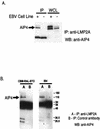Latent membrane protein 2A of Epstein-Barr virus binds WW domain E3 protein-ubiquitin ligases that ubiquitinate B-cell tyrosine kinases
- PMID: 11046148
- PMCID: PMC102158
- DOI: 10.1128/MCB.20.22.8526-8535.2000
Latent membrane protein 2A of Epstein-Barr virus binds WW domain E3 protein-ubiquitin ligases that ubiquitinate B-cell tyrosine kinases
Abstract
The latent membrane protein (LMP) 2A of Epstein-Barr virus (EBV) is implicated in the maintenance of viral latency and appears to function in part by inhibiting B-cell receptor (BCR) signaling. The N-terminal cytoplasmic region of LMP2A has multiple tyrosine residues that upon phosphorylation bind the SH2 domains of the Syk tyrosine kinase and the Src family kinase Lyn. The LMP2A N-terminal region also has two conserved PPPPY motifs. Here we show that the PPPPY motifs of LMP2A bind multiple WW domains of E3 protein-ubiquitin ligases of the Nedd4 family, including AIP4 and KIAA0439, and demonstrate that AIP4 and KIAA0439 form physiological complexes with LMP2A in EBV-positive B cells. In addition to a C2 domain and four WW domains, these proteins have a C-terminal Hect catalytic domain implicated in the ubiquitination of target proteins. LMP2A enhances Lyn and Syk ubiquitination in vivo in a fashion that depends on the activity of Nedd4 family members and correlates with destabilization of the Lyn tyrosine kinase. These results suggest that LMP2A serves as a molecular scaffold to recruit both B-cell tyrosine kinases and C2/WW/Hect domain E3 protein-ubiquitin ligases. This may promote Lyn and Syk ubiquitination in a fashion that contributes to a block in B-cell signaling. LMP2A may potentiate a normal mechanism by which Nedd4 family E3 enzymes regulate B-cell signaling.
Figures












Similar articles
-
The Epstein-Barr virus latent membrane protein 2A PY motif recruits WW domain-containing ubiquitin-protein ligases.Virology. 2000 Mar 1;268(1):178-91. doi: 10.1006/viro.1999.0166. Virology. 2000. PMID: 10683340
-
Itchy, a Nedd4 ubiquitin ligase, downregulates latent membrane protein 2A activity in B-cell signaling.J Virol. 2003 May;77(9):5529-34. doi: 10.1128/jvi.77.9.5529-5534.2003. J Virol. 2003. PMID: 12692257 Free PMC article.
-
PY motifs of Epstein-Barr virus LMP2A regulate protein stability and phosphorylation of LMP2A-associated proteins.J Virol. 2001 Jun;75(12):5711-8. doi: 10.1128/JVI.75.12.5711-5718.2001. J Virol. 2001. PMID: 11356981 Free PMC article.
-
Latent Membrane Protein 2 (LMP2).Curr Top Microbiol Immunol. 2015;391:151-80. doi: 10.1007/978-3-319-22834-1_5. Curr Top Microbiol Immunol. 2015. PMID: 26428374 Review.
-
Ubiquitination and endocytosis of plasma membrane proteins: role of Nedd4/Rsp5p family of ubiquitin-protein ligases.J Membr Biol. 2000 Jul 1;176(1):1-17. doi: 10.1007/s00232001079. J Membr Biol. 2000. PMID: 10882424 Review.
Cited by
-
HIV-1 Nef impairs heterotrimeric G-protein signaling by targeting Gα(i2) for degradation through ubiquitination.J Biol Chem. 2012 Nov 30;287(49):41481-98. doi: 10.1074/jbc.M112.361782. Epub 2012 Oct 15. J Biol Chem. 2012. PMID: 23071112 Free PMC article.
-
The E3 ubiquitin ligase Itch regulates tumor suppressor protein RASSF5/NORE1 stability in an acetylation-dependent manner.Cell Death Dis. 2013 Mar 28;4(3):e565. doi: 10.1038/cddis.2013.91. Cell Death Dis. 2013. PMID: 23538446 Free PMC article.
-
The G1 phase E3 ubiquitin ligase TRUSS that gets deregulated in human cancers is a novel substrate of the S-phase E3 ubiquitin ligase Skp2.Cell Cycle. 2015;14(16):2688-700. doi: 10.1080/15384101.2015.1056946. Cell Cycle. 2015. PMID: 26038816 Free PMC article.
-
Itch/AIP4 mediates Deltex degradation through the formation of K29-linked polyubiquitin chains.EMBO Rep. 2006 Nov;7(11):1147-53. doi: 10.1038/sj.embor.7400822. Epub 2006 Oct 6. EMBO Rep. 2006. PMID: 17028573 Free PMC article.
-
Roles of the ITAM and PY motifs of Epstein-Barr virus latent membrane protein 2A in the inhibition of epithelial cell differentiation and activation of {beta}-catenin signaling.J Virol. 2005 Feb;79(4):2375-82. doi: 10.1128/JVI.79.4.2375-2382.2005. J Virol. 2005. PMID: 15681438 Free PMC article.
References
-
- Alber G, Kim K-M, Weiser P, Riesterer C, Carsetti R, Reth M. Molecular mimicry of the antigen receptor signalling motif by transmembrane proteins of the Epstein-Barr virus and the bovine leukaemia virus. Curr Biol. 1993;3:333–339. - PubMed
-
- Beaufils P, Choquest D, Mamoun R Z, Malissen B. The (YXXL/I)2 signalling motif found in the cytoplasmic segments of the bovine leukaemia virus envelope protein and Epstein-Barr virus latent membrane protein 2A can elicit early and late lymphocyte activation events. EMBO J. 1993;12:5105–5112. - PMC - PubMed
Publication types
MeSH terms
Substances
Associated data
- Actions
LinkOut - more resources
Full Text Sources
Other Literature Sources
Molecular Biology Databases
Research Materials
Miscellaneous
